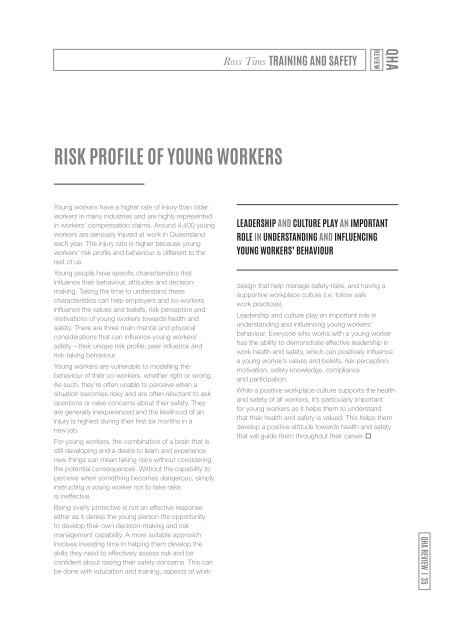QHA_February_Mag_Web
Create successful ePaper yourself
Turn your PDF publications into a flip-book with our unique Google optimized e-Paper software.
Ross Tims TRAINING AND SAFETY<br />
RISK PROFILE OF YOUNG WORKERS<br />
Young workers have a higher rate of injury than older<br />
workers in many industries and are highly represented<br />
in workers’ compensation claims. Around 4,400 young<br />
workers are seriously injured at work in Queensland<br />
each year. The injury rate is higher because young<br />
workers’ risk profile and behaviour is different to the<br />
rest of us.<br />
Young people have specific characteristics that<br />
influence their behaviour, attitudes and decisionmaking.<br />
Taking the time to understand these<br />
characteristics can help employers and co-workers<br />
influence the values and beliefs, risk perception and<br />
motivations of young workers towards health and<br />
safety. There are three main mental and physical<br />
considerations that can influence young workers’<br />
safety – their unique risk profile, peer influence and<br />
risk-taking behaviour.<br />
Young workers are vulnerable to modelling the<br />
behaviour of their co-workers, whether right or wrong.<br />
As such, they’re often unable to perceive when a<br />
situation becomes risky and are often reluctant to ask<br />
questions or raise concerns about their safety. They<br />
are generally inexperienced and the likelihood of an<br />
injury is highest during their first six months in a<br />
new job.<br />
For young workers, the combination of a brain that is<br />
still developing and a desire to learn and experience<br />
new things can mean taking risks without considering<br />
the potential consequences. Without the capability to<br />
perceive when something becomes dangerous, simply<br />
instructing a young worker not to take risks<br />
is ineffective.<br />
Being overly protective is not an effective response<br />
either as it denies the young person the opportunity<br />
to develop their own decision-making and risk<br />
management capability. A more suitable approach<br />
involves investing time in helping them develop the<br />
skills they need to effectively assess risk and be<br />
confident about raising their safety concerns. This can<br />
be done with education and training, aspects of work<br />
LEADERSHIP AND CULTURE PLAY AN IMPORTANT<br />
ROLE IN UNDERSTANDING AND INFLUENCING<br />
YOUNG WORKERS’ BEHAVIOUR<br />
design that help manage safety risks, and having a<br />
supportive workplace culture (i.e. follow safe<br />
work practices).<br />
Leadership and culture play an important role in<br />
understanding and influencing young workers’<br />
behaviour. Everyone who works with a young worker<br />
has the ability to demonstrate effective leadership in<br />
work health and safety, which can positively influence<br />
a young worker’s values and beliefs, risk perception,<br />
motivation, safety knowledge, compliance<br />
and participation.<br />
While a positive workplace culture supports the health<br />
and safety of all workers, it’s particularly important<br />
for young workers as it helps them to understand<br />
that their health and safety is valued. This helps them<br />
develop a positive attitude towards health and safety<br />
that will guide them throughout their career.<br />
<strong>QHA</strong> REVIEW | 35

















